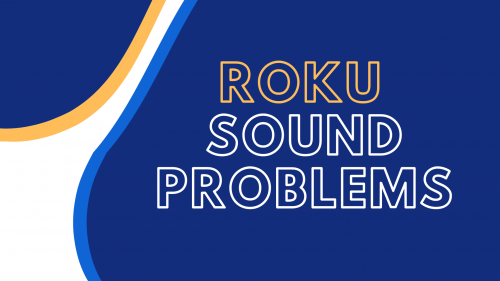
Every home theater system needs an alternative coaxial cable to create a secure connection for audio and video signals. And while this electrical cable is popular for better sound quality, did you know that it has different uses? In this in-depth review, join our resident audiophiles as we unravel when and how to use a coaxial speaker wire to aid your typical audiovisual needs.
What is a Coaxial Cable?
Before we go deeper into understanding the different uses of a coaxial cable, one must know the standard definition of this speaker wire. You may not be aware, but coaxial cables are generally used to accommodate the transmission of RF signals.
With a coaxial connection, this distinct speaker wire can carry high-frequency digital transmissions and lower audio output ranging from around 20 kHz to 300 GHz. However, unlike RCA, coaxial cables perform digital signal transmissions over analog.
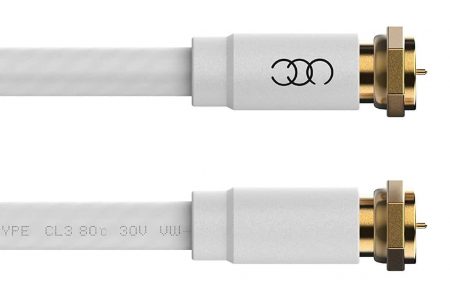
If you inspect it closely as our team did, you’ll notice that these speaker cables have an inner conductor and woven copper shielding that shares one axis. Because of this unique core wire construction, the name coaxial cable was brought to life.
Over the years, coaxial cables have been an essential part of every 20th century home sound system. Since getting patented in the 1880s, coax cables are known to deliver higher bandwidth and increased durability when compared side-by-side with a typical audio cable.
How Does it Differ from Digital Coaxial Cables?
For people unfamiliar with different speaker cables, you may find coax cable and digital coaxial cable a bit confusing. That’s alright. We’re here to explain. First of all, a coaxial digital connection produces more efficient signal transmission through electricity despite not being digital internally.
The digital coaxial audio cable also serves the same purpose and construction as coaxial cables, so it has ample impedance to go against the electrical current. On top of that, digital coax cable includes a center wire made of insulation material, a plastic case, and a metallic shield.
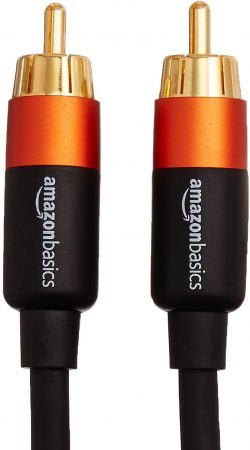
Sound equipment geeks like us highly preferred digital audio coaxial cable for its wide-range electrical frequency handling. Besides carrying digital audio signals, you’d be surprised that the coaxial digital audio cable is highly compatible with cable boxes, cable TV modems, runners, satellites, radios, TV antennas, and many more.
Components of Coaxial Cables
Like the typical digital coaxial cable, these coax cables have four known components in their construction. Our resident audio experts urge you to know these before purchasing coaxial cables based on your needs. At first glance, it may appear a simple speaker cable with a cylinder-like shape, but its tip is a core copper conductor wrapped with a dielectric insulator.
Depending on what kind of coaxial cable you bought, the type of insulators may vary from foam plastics, solid plastics, or air spacers. Next to that, you’d find a braided strand made of copper. This part of the coax cable is often referred to as the shield. With this component, the audio equipment can prevent losses and enhance performance.

Although you can find coaxial cable wires with four layers of shielding, making the cable thicker than it already is something our experts wouldn’t recommend, for it highly affects flexibility. The last layer for this speaker wire is the plastic jacket. Typically, it’s a Polyvinyl Chloride material, known for high resistance and toughness [1], but it all depends on the cable’s purpose.
Types of Coaxial Cables
No matter how much wire dilemma you’ve got, reading through the RG standard is the best solution you can rely on when dealing with a coaxial cable setup. Each speaker cable type tells you its compatibility features through core coax cables diameter, outer measurement, and where it’s commonly used.
Radio Guide Standard
| Cable Types | Core Diameter | Outer Diameter | Purpose |
| RG-58/U | 0.81mm | 5mm | Radio Communications, Ethernet, Amateur Radio |
| RG-59/U | 0.64mm | 6.1mm | HD/HQ RF video transmission (short distance) |
| RG-8/X | 1.47mm | 6.1mm | Amateur Radio Transmitters |
| RG-6/U | 1.024mm | 6.86mm | Cable TV systems, Satellite TV, Cable Modems |
| RG-6/UQ | 1.024mm | 7.57mm | Cable TV, Satellite TV, better shielding capacity than RG-6/U |
| RG-7 | 1.3mm | 8.13mm | Satellite TV, Cable Modems, Cable TV |
| RG-8/U | 2.17mm | 10.3mm | Amateur Radio |
| RG-11/U | 1.63 | 10.5mm | Cable Modems, Cable Television, Satellite |
| RG-60/U | 1.024mm | 10.8mm | Cable Televisions, Cable-connected Internet |
Construction
Flexible
When shopping for coax cables, flexible ones are the most common type that you’ll encounter in the market. If you look closely, you’ll differentiate this speaker wire from the rest with its braided cable design. Despite its known flexibility among different coaxial cables, our team wouldn’t suggest this option if you’re looking for added shielding as it’s prone to signal leaks.
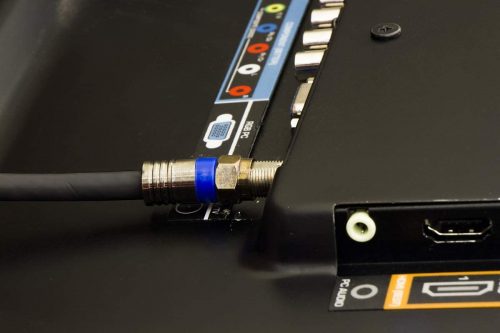
Semigrid
If durability is your priority for coaxial cables, we urge you to select a Semigrid speaker wire instead. With construction similar to pipes and a metallic exterior that serves as a conductor, rest assured that this speaker cable has uniform impedance and high shielding capabilities. However, keep in mind that it may not be as flexible as the last type we discussed.
Triaxial
Another coaxial speaker cable worth considering for increased shielding and noise resistance is the Triaxial coax cable. Unlike other kinds, this speaker wire is composed of two conductors. One is for signal grounding, while the other is for earth grounding.
Dual
To save you time and money, there are also coaxial cables used in dual-wired installations. These are the typical speaker cable types used for television antennas, satellites, and cable setups.
Impedance
Another crucial feature that would differentiate each coaxial speaker wire is its impedance. This feature an audible effect in sound quality, so our resident audiophile highly recommend checking this part of the post.
50 ohms
If you’re looking for a speaker cable to use in radio transmission applications or transmitter antennas, then 50-Ohm wire options are the best recommendation our resident audiophiles can give. Besides high-frequency audio transmission, these wires can accommodate Coaxial Ethernet Networks.
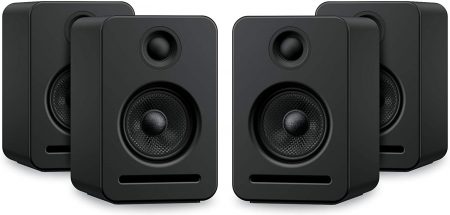
75 ohms
The speaker cables highly suited for household usage are the ones with 75 Ohms impedance. If you happen to have a coax speaker cable lying around your toolbox, it’s most likely a 75-Ohm. It can also be used for cable television systems and other video device transmissions.
Coaxial Cable Connectors
When you connect speaker wire cables to a device, there are connectors specifically designed to shield these connections. If you’re a newbie, chances are you can’t pick out the right one for your digital audio needs, so take a closer look below to get the gist of its importance.
BNC
BNC connectors are short for Bayonet Neil-Concelman. These wires are generally used for televisions, testing instruments, radiofrequency equipment, and radios. Besides its convenience, our resident audiophiles are fond of this connector for its stable wide-range frequencies from 10 GHz up to 4GHz. However, anything after that may produce radiation and losses.
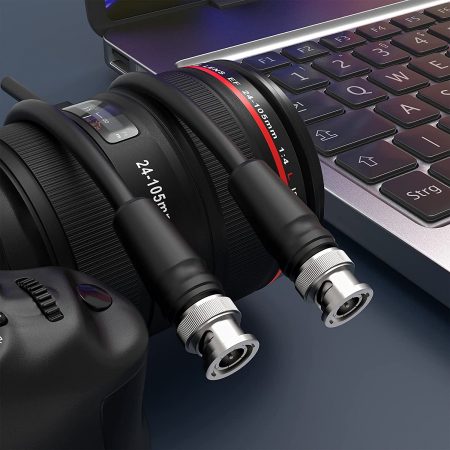
N-Type
If you’re aiming for the lower spectrum of microwave frequencies ranging around 18 GHz, N-type connectors will surely deliver the result you need. Most broadcast equipment uses this type of connector as well.
SMA
For working with frequencies 0 Hz to 24 GHz, the best option you can consider is SMA connectors. This audio receiver component works well with antenna systems for radio and mobile. You can also count on them when handling microwave systems.
F-Type
Among the choices here, F-type connectors are by far the most typically seen in the market as they’re highly suited for TVs and antennas. No need to worry, though. Despite its availability, this connector has frequency handling up to 1GHz.
RCA
Another common option to consider are the RCA connectors. Known for both audio and video connection, it’s not a surprise that it can accommodate frequencies ranging up to 10 MHz. If you’re having trouble finding one in the market, RCA connectors are also popularly called cinch connectors.
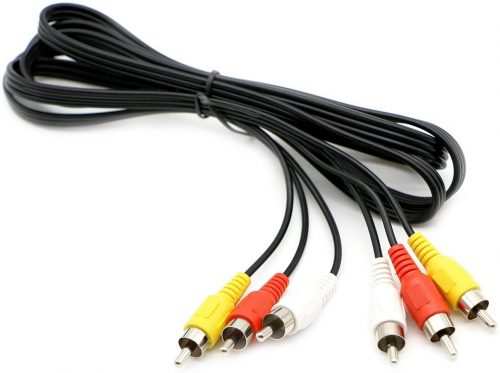
MCX
Not all equipment in need of connectors are the same. So if you need one to cater to applications that are limited in size or space, then micro coaxial connectors can save the day. It’s designed as an ideal pair with antennas and boards.
TNC
The Threaded Neil-Concelman (TNC) options are basically the same as BNC but come as a threaded version. However, our team would recommend TNC connectors than BNC when it comes to working with microwave frequencies.
Pros and Cons of Coaxial Cables
Advantages
Compared to using regular twisted pair cables, coax wires are actually less prone to noise and interference. Our testers found great delight working with it in the short distance because it still delivered reliable performance. It has a thicker conductor than RCA cables and a relatively lower induction rate.
If you buy the likes of Mogami cables, you’ll also notice that their impedance highly suits the needs of a speaker wire. And because it has higher bandwidth than optical connection, users can expect this wire to produce better sound production.
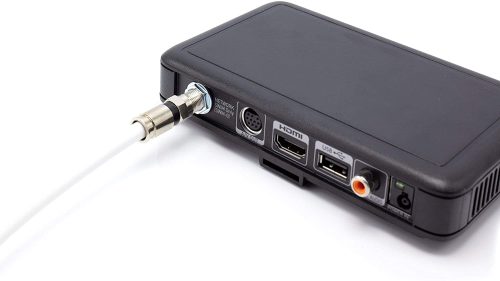
These cables are also widely used in a professional setting as they have high durability that can cope with the needs of different environments. Audiophiles on a tight budget can benefit from this because they’re extremely affordable without any fear of compromising their quality.
Disadvantages
Every perk comes with a disadvantage. Unfortunately, coax speaker cable is no exception to this. The usage of this kind of audio signal transmission may produce electrical noise one may find displeasing.
And while these cables are known for superior elevating the quality of audio connections, coaxial setups don’t support popular sound technologies like DTS-HD Master Audio. If you’re keen on extensive and heavy usage, you may find its speed fluctuating from time to time.
The wire length can pose instability issues, and the installation for long distances can easily incur higher costs due to the cable’s thickness. It’s also crucial to note that signal leakage may happen anytime during the course of the connection.
Coaxial vs. Optical vs. HDMI Cables
If we’re comparing optical to coaxial speaker wires, our resident audiophiles can bet 100% that the latter sounds better. Coaxial transmissions carry higher bandwidth than an optical digital connection with 192 kHz versus 96 kHz.
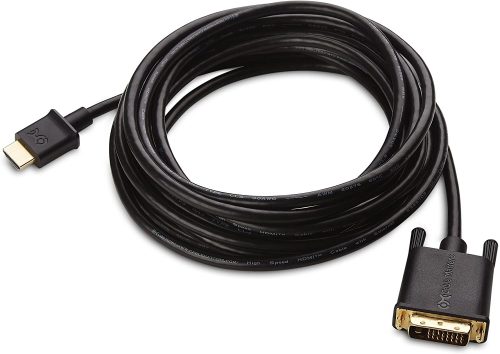
However, the inability to accommodate lossless audio formats makes both optical cable and coaxial wire similar. On the brighter side, optical connections can be directly connected to an AV receiver’s DAC as it restricts noise passing from the source device to the circuit. These cables can support uncompressed PCM audio channels as well.
Compared to coaxial and digital optical cables, an HDMI connection offers incomparable bandwidth. These types of audiovisual wires can accommodate updated sound formats from Dolby True HD to DTS Master Audio. The same applies to video formats as they can work well with 4K Ultra HD resolutions and various HDR configurations.
Is a Coaxial Speaker Cable Better Than an RCA Cable?
Although RCA cables and coaxial speaker wires tend to look alike and are often substituted with one another, they have slightly different capabilities you may need to consider.
Setting aside how coax wires are thicker than RCA cables, coaxial is more preferred because of its compatibility with 5.1 channel audio using one cable. You may not know it, but this kind of setup isn’t possible with RCA cables.
Another advantage coax options have over RCA cables is their impedance. Upon inspecting, our team concluded that coaxial cables typically have 75-Ohm impedance, whereas RCA has 50.
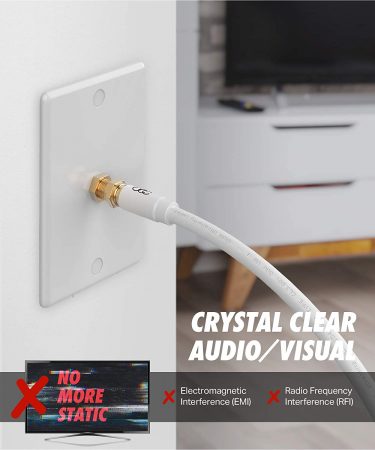
And above all else, coaxial speaker wires support a wider range of frequency bandwidth. With this, there’s no doubt that its component can work through different audiovisual applications out there.
Can You Use a Coaxial Cable For Subwoofers?
Yes, you can use this type of audio cable for subwoofers. In fact, there are specifically designed speaker cables meant for woofers that offer higher quality sound and uninterrupted connection. All you need to do is find yourself a wire stripper or a sharp utility knife to remove all the existing connectors to your subwoofer before you start hooking up a coax wire.
Any type of coaxial cable will work with no specific impedance requirements. As you may know, subwoofers require wires with strong shielding, so it’s not a bad idea to consider coax cables for these connections.
FAQ
Is a coaxial speaker cable good for audio?
Yes, a coaxial cable is good for audio transmission. Besides typical speakers and subwoofers, coax wires can also be used as microphone cables as they’re known to deliver from low frequencies to high noise ratios. You can also count on these digital audio cables to ensure secure connections.
Conclusion
Coaxial speaker cables aren’t hard to find in the market nowadays, so it won’t be long until you sight one when you decide to shop for home theater equipment. And now that you’re well-informed on how coaxial cables work, our resident audiophiles highly suggest putting your audio needs first and taking your time before jumping into any purchasing decisions.
The post A Complete Guide on Coaxial Speaker Cables <br> (Must-Read Facts & Tips) appeared first on The Product Analyst.
from The Product Analyst https://theproductanalyst.com/coaxial-speaker-cable/
No comments:
Post a Comment